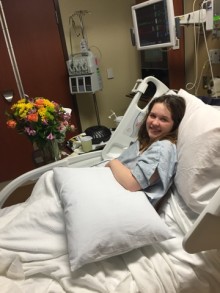The first Georgia patient ever diagnosed with the plague is recovering at home after a week in a Thomasville hospital.
Hannah Lindquist, 18, probably was bitten by an infected flea while hiking with her family in Yosemite National Park in California, her father, Ben, told GHN on Wednesday.
Hannah, under doctors’ orders, will take a semester off from Valdosta State University, where she is a sophomore majoring in biology and pre-med, said Ben Lindquist, an attorney in Thomasville.
“Although still on Doxycycline [an antibiotic], medically Hannah is cured and is now in the process of recuperating and regaining her strength,’’ noted her father. “Thankfully, all Hannah’s tests have returned normal.”
He added, though, that “Hannah’s doctors have cautioned it will be a while before she’s feeling 100 percent.”
Lindquist credited “God’s mercy,” his wife’s quick action, and a doctor prescribing the right antibiotic as helping save Hannah’s life.
Hannah was diagnosed with bubonic plague, which is not contagious, her father said.
The state Department of Public Health announced last week that an individual in Georgia had the disease, but did not identify her at that time.
Plague, an infectious bacterial disease, is infamous for killing millions in Europe during the Middle Ages, when its cause was unknown and unsanitary conditions sometimes allowed it to spread uncontrollably. But plague is now well understood, public health practices have drastically limited its spread, and modern antibiotics are effective in treating it.
Though the disease once devastated crowded cities, it now tends to occur as isolated cases, sometimes in wilderness areas.
Plague first arrived in the United States in 1900. From then until 2012, more than 1,000 confirmed or probable human plague cases occurred across the nation. But before Hannah, there had never been a recorded case of human plague in Georgia.
Lindquist said his wife, Heather, received an article from her brother on a prior case of plague at Yosemite as the family was about to leave California. Four days after their return to Georgia, Hannah came down with symptoms, including swelling of her lymph nodes, fever and severe body pain.
Heather grew alarmed, researched the plague, and brought Hannah to Archbold Urgent Care, where she received what turned out to be the life-saving Doxycycline, Ben Lindquist said. Then she was admitted into Archbold Medical Center.
Plague’s impact
Plague can look like the flu and can turn into a deadly illness if not treated promptly with antibiotics. Symptoms include a sudden fever, a severe headache, nausea and chills.
“It was clearly life-threatening,’’ Lindquist said. Without the rapid response by his wife and medical providers, he added, “it is very likely she would have died.”
“We’re very thankful to God for mercifully protecting our precious daughter,’’ he told GHN.
Lindquist said he’s glad that there now are more cautionary reports about the plague and Yosemite.
Hannah is “very disappointed that she had to withdraw from the semester, but she is very thankful simply to be alive,” he said.
But Lindquist added that his daughter has a new view of her future career in the health field, having overcome a notoriously frightening disease as a patient.
“She wants to practice medicine one day, and she received quite the education from a patient’s perspective,” he said.
In addition to the California cases, two people contracted the plague this year in Colorado, CNN reported. Both of them died of the disease.
Plague is carried by squirrels, chipmunks and other wild rodents and their fleas. (Rats were the rodents in the huge outbreaks of the Middle Ages.) When an infected rodent becomes sick and dies, its fleas can carry the infection to other warm-blooded animals, including humans.
Plague is not transmitted from human to human unless it takes the form of a lung infection — pneumonic plague — and the patient is coughing. Even then, human-to-human transmission is rare and typically requires direct and close contact with the person with pneumonic plague.
The CDC reports that the United States has about seven cases of plague annually.


